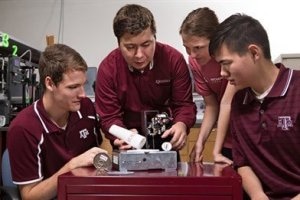Mar 13 2017
Researchers from Texas A&M University's Mechanical Engineering department have used 3D printers to create high quality adhesive labels in braille for a variety of consumer products.
 The team working on 3D printing of braille labels (from left to right): Cullen Chovanec, Tanil Ozkan, Madeleine Horelica and Joshua Vandervort. (Credit: Texas A&M University)
The team working on 3D printing of braille labels (from left to right): Cullen Chovanec, Tanil Ozkan, Madeleine Horelica and Joshua Vandervort. (Credit: Texas A&M University)
The project was carried out to benefit the visually impaired and the undergraduate students carrying out the research and development, within one study. Though professors and teachers supervised the group, the students were given the freedom to actively engage themselves within all facets of the project.
According to Dr Tanil Ozkan, the assistant professor of instruction at Texas A&M University who led the project, the dynamics of the American consumer market can mean distributors fail to include braille labelling on their packaging.
During the research, the team deemed the standard 3D printing polymers used in applying 3D-printed braille packaging as unreliable. The solution was durable adhesive labels to allow easy printing and adhesion to the packages.
“We’ve had a former undergraduate and current graduate student here at Texas A&M, Yasushi Mizuno, develop a non-contact sensor technology which detects surface curvature and height differences on the plane of the labels so that optimal process parameters can be determined with the digitally generated surface within the software for the subsequent 3D printing,” said Dr Ozkan. “This allows the labels with the braille to fit the surface well.”
Ozkan and his students developed a portable and compact 3D printer in a bid to ensure that braille labels could be printed with ease. One of their main concerns was that ordinary people would find the technology difficult to operate, generally uncommon among commercially available 3D printers.
“We have developed some software and written our own code that would basically create these braille characters and then place them, with the desired size font, on the label,” Ozkan added. “This still requires some level of technical expertise, so what we are thinking is that if we combine this technology with a portable 3D printer, this can be taken to schools, nursing homes and public libraries where the blind and visually impaired members of our society have access to other services.”
Texas A&M’s Mechanical Engineering department is hopeful their 3D-printed braille labels will be as effective a solution for the visually impaired, as it has been an educational tool for its undergraduates.
“The goal was to have my undergraduate students engaged in every step of the project,” Ozkan reflected. “With any kind of product development or innovation, it is always the case that when you start learning things and get more experience, you kind of become rigid in terms of what you can and cannot do. Young minds don’t have these restrictions, and in many cases not knowing anything about the rules is exactly what you need for great innovation.”